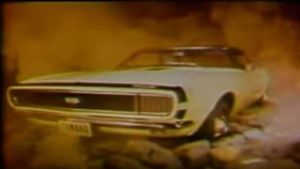Want to get your latest classic car purchase across the Atlantic? It needn’t be as complicated as it sounds if you follow our comprehensive guide
When hunting for that dream classic, your search may lead you to some interesting places. If you’re the lucky sort, there may be a great example lurking under a decade of dust and cobwebs in someone’s barn only a few miles from your house. If your particular classic is an exotic foreign job, then that shed may be located on another continent entirely.
Most people stop at this point, let out a slow sigh and continue their search a little closer to home. Importing a car from overseas can at first seem a daunting task; the paperwork, procedures and unknown costs can deter even a seasoned collector. As with most things, however, understanding the process can make all the difference.
More on American cars
So, to make the procedure as painless and straight forward as possible, we’ve done the digging for you and laid out the specific requirements to import a car into the UK from the US. Let’s start at the beginning – as good a place as any.
Preparing classic car for shipping

You’ve finally found that perfect classic waiting for you in the US, so it will now need to be prepared for its trip to the UK. The very first step is to identify a vehicle-shipping specialist and get the car to them.
The majority of reputable specialists offer a collection service from most locations within the United States, and unless you are planning to drive the car to the shipper yourself, this is the safest method to get it to the departure point. Some shippers outsource the collection service to transport companies that may not specialise in classic cars, so be sure to enquire about this.
Transport company insurance limits vary, and if the vehicle is worth more than $1,000,000 special arrangements usually have to be made to ensure the amount can be covered. If you’re transporting a high-value classic, then additional spending on a closed trailer is well worth the extra expense.
If the car has any peculiarities, such as a quirky starting procedure or perhaps a mechanical fault, be sure to inform the shipper beforehand. It is also advisable to have the car fully photographed and its condition recorded before it leaves the seller’s premises.
Unless you’re buying a non-runner, the car should be in roadworthy condition if you intend to use it on British roads. Certain modifications may also be needed to make the model legal for the UK, although this can be done once it’s arrived. As your car will need to travel with an empty fuel tank, most shippers will drain the excess petrol for you – just don’t expect it to be poured back in at the destination point.
Dmitriy Shibarshin of West Coast Shipping, which specialises in exporting cars from the US to the UK, says a lot of buyers enquire about any taxes they might have to pay. The good news is that as long as you are not planning to register and drive the car in America you will not need to pay any taxes or custom duties.
What you will need is the original vehicle title, your passport and a bill of sale, which must all be submitted to customs for clearance. The entire process can take up to a week.
Shipping a classic car
The choice of air or sea travel comes down to cost, and most classics tend to be sent by sea. Some specialists also allow you to ship parts and spares inside your car, so it is worth enquiring about this – especially if the items are bulky or will need fitment once the vehicle lands in the UK.
Dmitriy maintains that shipping via a container remains one of the most effective ways to export a vehicle. ‘It is the preferred method when shipping classic cars, project cars, cars with parts inside, and high-value cars that don’t get shipped by airplane,’ he says.
West Coast Shipping, for example, helps cut costs further by using consolidated containers that fit up to three cars at a time. Getting your vehicle from California to the UK costs around $1300 and take up to a month. New Jersey to the UK is $900 and cuts the shipping time down to just under two weeks.
Dedicated containers are also available but can be triple the price. Transport insurance is optional but vital for peace of mind, and it usually costs around two percent of the vehicle’s value. The percentage can decrease for very expensive cars.
Approximately 5000 cars were exported from the US via containers last year. Southampton was the most popular port, followed by Felixstowe. Unsurprisingly, Ford and Chevrolet were the two most popular brands to be imported, and Jaguar and Triumph were third and fourth on the list. Salvage auctions are also proving quite popular, with both modern exotics and classics finding their way to the UK as project cars.
Classic car customs paperwork
Once the car has landed in the UK, it will need to be collected from the port and cleared by the local customs agents. There are a number of steps that need to be followed, and most shippers will be happy to assist you; you should budget around £475 for this process. However, it’s still worth knowing the procedures as some steps need to be completed by you.
Using a NOVA for import tax

The first of these is to inform HM Revenue and Customs (HMRC) that the vehicle is in the UK, within 14 days of its arrival. This can be done using the Notification of Vehicle Arrivals (NOVA) online tool. A paper notification option is also available but will take a lot longer.
The relevant taxes and VAT that need to be paid will then be calculated. If your car was built outside of the EU, then the duty will be 10 percent of the total price and you will pay 20 percent VAT on top of that figure.
If the car is over 30 years of age, is largely standard and will not be used as a daily driver, then the duty can be waived and the VAT portion is reduced to 5 percent. Dmitriy says that a large number of expensive classics are imported through the UK because this is currently the lowest import duty in the EU.
If you are a private individual or are importing the car through a non-VAT-registered business, then you will not be required to fill in the NOVA form. Don’t get excited just yet, however, as you will still need to contact the HMRC to find out exactly what alternate forms you’ll need to fill in.
Registering an imported car
Once the payment has been made, HMRC will provide online confirmation that the vehicle can be registered with the DVLA. For this process you will be required to complete the following and send it to the DVLA:
- Fill in a V55/5 application form.
- Pay the vehicle tax as specified by HMRC.
- Supply an original non-UK registration document (this will not be returned to you). If this document is unavailable, you will need a letter with a dating certificate from the manufacturer.
- Certificate of insurance using the Vehicle Identification Number (VIN).
- A fresh MoT certificate. Some cars may also need to have modifications carried out – such as fitting amber indicator lenses – before they’re allowed to be driven in the UK.
- Photocopies of your name and address; a UK driving licence or passport for the name, and a current utility bill for the address, will suffice. If you’re importing the car through a business you will be required to provide proof of your business address.
- Evidence of Type Approval. This can be in the form of a Certificate of Conformity, Mutual Recognition Certificate or evidence of previous UK registration (V5C form). If none of these forms is available, an Individual Vehicle Approval (IVA) test will need to be carried out.
- The first registration fee may need to be paid. This amounts to £55 and can be paid only via cheque or postal order to the DVLA. An online payment system would have made it all too easy...
Transporting your car home

Finally, once this has all been completed the car will need to be taxed, insured and fitted with UK number plates. You can choose to have your vehicle stored at the agent’s warehouse until you are ready to collect it, or have the agent deliver it straight to your door, for a fee.
Once you see your gleaming classic, the many forms, weeks of waiting and associated costs will soon fade into the background, and the fact that you’re finally behind the wheel of your dream car will be all that matters. Just make sure to follow the steps required and use a reputable shipping agent, and you’ll find that importing a classic can be almost as seamless as collecting one from that barn down the road.




